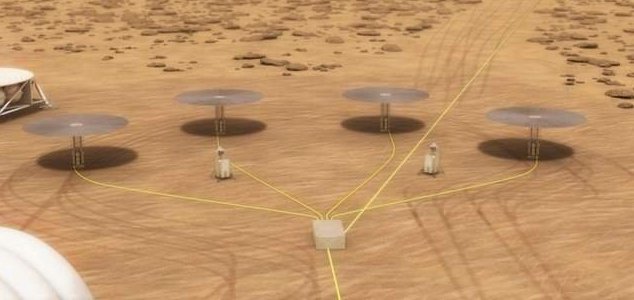Space & Astronomy
January 19, 2018 · 14 comments
14 comments

These reactors could power a whole base. Image Credit: NASA / YouTube / Los Alamos National Lab
Available in either a 1KW or 10KW configuration, the reactor has the potential to power everything from astronaut living quarters to the facilities needed to turn raw resources in to usable fuel.
By comparison, the power source on the Mars Curiosity rover only generates 120 watts.
"Your toaster uses about a kilowatt," said Kilopower project lead Pat McClure. "In your average household, you use about 5 KW on average a day, at any given time."
"Realize, though, that this is a lot of energy for NASA. At NASA they're used to tens to hundreds of watts. So to have a kilowatt or 10 kilowatts is a lot of electricity."
One of the biggest concerns regarding the use of nuclear reactors in space is what happens if the launch goes wrong and the dangerous nuclear materials fall back down on to the planet.
In this case however, McClure maintains that the Kilopower reactor is nothing to worry about.
"People always think you're going to fly Chernobyl into space or something," he said. "Before you fission a reactor there are some minor amounts of radioactivity that exist in the core, because it is uranium, but its very small. If something were to happen in a launch accident, it's really not going to present a problem to the public."
"You're talking far less than a millirem for a peak dose. Most people would be in the microrem range. It's far, far less that you would receive from background radiation, or taking an airplane flight."
Source: Popular Science | Comments (14)
Mini nuclear reactors could be used on Mars
By T.K. RandallJanuary 19, 2018 ·
 14 comments
14 comments
These reactors could power a whole base. Image Credit: NASA / YouTube / Los Alamos National Lab
The Kilopower project has developed a type of miniature nuclear fission reactor for use on other worlds.
Created through a joint venture between NASA and the Department of Energy, the reactor, which will soon undergo testing in the Nevada desert, could become an integral part of future missions to Mars.Available in either a 1KW or 10KW configuration, the reactor has the potential to power everything from astronaut living quarters to the facilities needed to turn raw resources in to usable fuel.
By comparison, the power source on the Mars Curiosity rover only generates 120 watts.
"Your toaster uses about a kilowatt," said Kilopower project lead Pat McClure. "In your average household, you use about 5 KW on average a day, at any given time."
One of the biggest concerns regarding the use of nuclear reactors in space is what happens if the launch goes wrong and the dangerous nuclear materials fall back down on to the planet.
In this case however, McClure maintains that the Kilopower reactor is nothing to worry about.
"People always think you're going to fly Chernobyl into space or something," he said. "Before you fission a reactor there are some minor amounts of radioactivity that exist in the core, because it is uranium, but its very small. If something were to happen in a launch accident, it's really not going to present a problem to the public."
"You're talking far less than a millirem for a peak dose. Most people would be in the microrem range. It's far, far less that you would receive from background radiation, or taking an airplane flight."
Source: Popular Science | Comments (14)

The Unexplained Mysteries
Book of Weird News
AVAILABLE NOW
Take a walk on the weird side with this compilation of some of the weirdest stories ever to grace the pages of a newspaper.
Click here to learn more

Support us on Patreon
BONUS CONTENTFor less than the cost of a cup of coffee, you can gain access to a wide range of exclusive perks including our popular 'Lost Ghost Stories' series.
Click here to learn more
Natural World
Spirituality, Religion and Beliefs
Israel, Palestine and the Middle-East
Philosophy and Psychology
Total Posts: 7,604,368 Topics: 316,282 Members: 201,819
Not a member yet ? Click here to join - registration is free and only takes a moment!
Not a member yet ? Click here to join - registration is free and only takes a moment!





























Please Login or Register to post a comment.